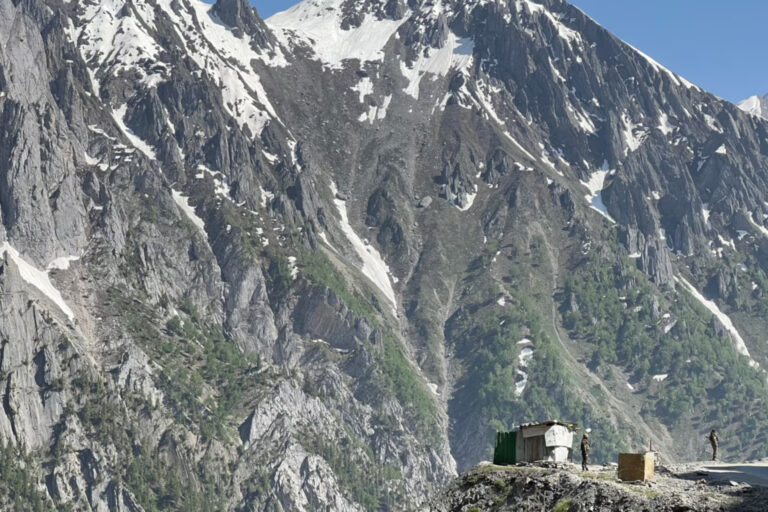In 1972, in anticipation of the UN Conference on the Law of the Sea, the SAIS Review published an issue focused on maritime law. This year, the SAIS Review revisited international law and the sea, as well as resource management, sovereignty and territorial disputes, piracy and other maritime threats. On Monday, December 9th, the SAIS Review hosted a panel discussion to celebrate the release of its latest issue: “Uncharted Waters: New Trends in Piracy, Sovereignty and Ocean Resources.”
Panelists
Mr. James Bridger is a Maritime Security Consultant with Delex Systems Inc. in Herndon, Virginia. His work focuses on piracy, terrorism and other irregular threats to global maritime transportation. James previously served as a Senior Research Analyst at the Atlantic Council of Canada. He holds a Master of Arts in Political Science from the University of Toronto.
Ms. Caitlyn Antrim is the Executive Director of the Rule of Law Committee for the Oceans, a committee of experts in international law and policy for the oceans. Her work focuses on the geopolitics of Arctic governance and implementation of the Law of the Sea Convention. Ms. Antrim has served as a Deputy U.S. Representative to the Third UN Conference on the Law of the Sea, Senior Analyst and Project Director at the Congressional Office of Technology Assessment, Policy Analyst in the Office of the Secretary of Commerce, and an officer in the U.S. Navy. Ms. Antrim earned her undergraduate and graduate studies at the Massachusetts Institute of Technology.
Dr. William Komiss is a senior research scientist at CNA. He also serves as the Scientific Analyst for the Director of the Energy and Environmental Readiness Division in the U.S. Navy. With CNA, he has worked primarily on issues related to energy, including the compatibility of renewable energy and Navy activities, economic impacts of disruptions to oil chokepoints, and links between water and energy consumption. Dr. Komiss has a Ph.D. in Economics from Stanford University and a B.A. in Economics from the University of Texas at Austin.
Panel Discussion
Caitlyn Antrim began the discussion by introducing the foundations of maritime law: the Law of the Sea Convention and the UN Conference on the Environment and Development. The Law of the Sea Convention, adopted in 1982, is a state-only agreement that establishes a governance structure for the international sea bed, including marine environment protection. Previously, this area had no restrictions; instead, it was governed by an informal “gentleman’s agreement,” in which states would attempt whenever possible to make decisions by consensus, and no state would interfere with another’s territory. While the Law of the Sea is the “constitution for the oceans,” the 1992 UN Conference on the Environment and Development provides a greater framework: guidelines, norms, processes for making laws, and conflict resolution mechanisms.
Ms. Antrim noted that decision-making by consensus is a norm of international ocean governance. For example, the Arctic Council – a forum for the eight Arctic countries, including the United States – emphasizes negotiation, discussion and coordination in response to Arctic issues, rather than voting. Consensus is also a feature of the Law of the Sea Convention: A commission determines how far state sovereignty extends into the seabed through a technical and legal evaluation, yet the commission’s decision requires consensus by all parties to the convention. Notably, the U.S. Congress has not ratified the Law of the Sea Convention.
Crafting an international regime that can gain international consensus is a difficult yet rewarding challenge, Ms. Antrim said. She concluded by remarking upon the intimacy of the ocean law community, which cuts across countries and fields of expertise. “You argue during the day, and then have dinner together in the evening,” she said. “It is a wonderful field to work in.”
James Bridger discussed contemporary piracy in the Africa’s east and west coasts: the Horn of Africa and the Gulf of Guinea. He began by introducing conditions that enable piracy in both East and West Africa: favorable geography, including naval chokepoints and bustling trade; a permissive political environment, with weak central governments and local authorities that tolerate or profit from piracy; conflict and disorder in coastal states; inadequate law enforcement and security, including understaffed naval forces and failed coast guard patrolling; and finally, the lack of economic opportunity, with comparison to the great profits that can be gained through piracy.
Piracy in Somalia grew from a regional problem to an international crisis between 2007 and 2008, when piracy became “professionalized” and developed into a lucrative enterprise. Between 2009 and 2010, piracy continued to spread; in response to international patrols in the Gulf of Aden, piracy expanded a thousand miles in all directions, towards India and Mozambique. Between 2011 and 2012, the success rate of pirate attacks declined, as ships implemented private defense measures (such as armed guards aboard vessels) and international navies improved their coordination. Furthermore, there have been modest political and social changes among coastal areas, where some communities have rejected piracy. However, the conditions and networks that contributed to piracy’s rise remain intact, so piracy may experience a resurgence if security measures diminish, Mr. Bridger noted.
In the Gulf of Guinea, early piracy was characterized by unorganized, opportunistic oil tanker hijackings, in which hijacked oil was distributed in networks in Nigeria. These maritime kidnappings and ransoms reached a high between 2006 and 2009. However, starting in 2010, piracy became more sophisticated, as “extended-duration tanker hijackings” has spread across the region. An oil tanker will be targeted by a powerful, well-connected criminal group, and ambush the ship with rockets and machine guns. The ship’s communication equipment and identifiable physical features are destroyed, and its oil is offloaded onto another ship, and then resold on the black market to a prearranged buyer. “If you’re considering a career in piracy, it’s far more lucrative in Nigeria than it is in Somalia,” Mr. Bridger said. “You can steal five, six million dollars’ worth of oil in a couple of days, rather than having to wait out a ransom negotiation for a year or more, as is the norm in Somalia.”
Mr. Bridger concluded with a comparison of the two piracies: Somali and Nigerian piracy have similar enabling factors, but they are rooted in local contexts and have different modus operandi. Thus, the counter-piracy tactics that have succeeded in Somalia are largely inapplicable in Nigeria. Somali piracy will remain suppressed as long as armed guards and naval patrols remain in place, Mr. Bridger said. Finally, Nigerian piracy is not “exploding,” as many media sources suggest, but shifting and evolving with greater sophistication. There is no “silver bullet” response to Gulf of Guinea piracy, he said.
The final panelist, William Komiss, discussed the economic and strategic impacts of disruptions to oil chokepoints around the world. As part of CNA’s team working for the Chief of Naval Operations for the Strategic Naval Warfare Group of the United States Navy, Dr. Komiss had researched and quantified the effects of oil chokepoint disruptions. This particular study was a “pressing concern” for the Navy, as Dr. Komiss noted, as they were evaluating their strategic responses to oil crises.
CNA’s research focused on specific chokepoints: the Panama and Suez canals, the Turkish Straits, the Bab al-Mendeb strait, and the straits of Malacca and Hormuz. Dr. Komiss took care to define a chokepoint as a “narrow channel of water,” which is “critical to the world’s energy network.” Other chokepoints were considered, such as those of the coast of India; however, the aforementioned seven were considered the most vital.
Why are oil chokepoints important? As Dr. Komiss noted, disruptions to oil chokepoints can be linked to economic and political instability. CNA was “agnostic” in considering threats, both manmade and natural: piracy, conventional military action, and environmental disasters were considered. CNA’s study focused on how quickly a disruption to the world’s oil supply at one of these chokepoints would affect the world’s major economies. CNA also operated under the assumption that there were two options to mitigate the effects of disruptions at these chokepoints: the use of pipelines or alternative sea routes. CNA did not consider the use of strategic reserves as an alternative for this study, as that would have required modeling behavioral responses; the alternatives weighed by CNA could be quantified in a relatively simple way.
Dr. Komiss then went into detail as to the importance of various straits and the disastrous effects of disruptions therein; Hormuz and Malacca, for example, are the two most important, with an average of 17 and 15 million barrels of oil per day passing through on average. Disruptions in the Strait of Malacca cannot be mitigated through pipelines, though disruptions through Hormuz can. Disruptions to the Panama Canal require a detour around the tip of South America that add eight thousand nautical miles to a ship’s journey; other detours are not nearly as significant.
Dr. Komiss’ team at CNA then found that the most severe effects of a disruption at a chokepoint would be felt in South Korea, Singapore and Indonesia; in Indonesia, it would take a mere 69 days of a 20% disruption of an oil chokepoint to cause a one percent spike in unemployment. What are the strategic implications? Dr. Komiss’ conclusion came to three specific recommendations or implications: that the Navy may have to intervene in the case of a disruption, either by supplying oil or forcibly opening a chokepoint; that international producers may have to look to supply Southeast Asia; and, perhaps most importantly, that agreements regarding oil chokepoint supply and crisis management may have to be concluded proactively.
Kendrick Kuo then opened the question and answer session with a well-rounded question on the role of natural resources in maritime issues, and how the race for these resources may drive countries to competition or cooperation. Mr. Bridger opened the panel’s responses by noting that piracy has been a “great spur” of cooperation in the past two decades, with cooperative agreements in Southeast Asia and East Africa allowing for international support to end piracy. Dr. Komiss then described the contemporary era as an interesting time for “competition by coordination and cooperation,” noting that though the world’s biggest economies are competing for resources such as oil, it is in their best interests to work together to protect the flow of such resources.
Ms. Antrim added that, though the Law of the Sea Convention’s inclusion of exclusive economic zones of up to 200 nautical miles has great “in theory,” many maritime states do not have the resources or “culture” to provide basic maritime functions such as Coast Guard protection. In these cases, cooperative unions to protect maritime areas are the most useful. However, Ms. Antrim noted that, despite these cooperatives being the best force against piracy and maritime crime, they are hard to define and limit under international law; the current international force protecting Somali waters – the force that allows the US Navy to arrest people within “six nautical miles” of Somalia’s coastline – required a UN resolution specifically for that purpose. Ms. Antrim also noted that the U.S., Canada, and Russia’s cooperation in the Arctic on search and rescue procedures are also an excellent example of maritime cooperation.
Mr. Kuo then opened up the panel to floor questions.
[youtube=http://www.youtube.com/watch?v=5UGBJFW7AFA&feature=youtu.be]
This post was a collaborative effort by Senior Editor Lauren Caldwell and Web Editor Rachel Ostrow.



